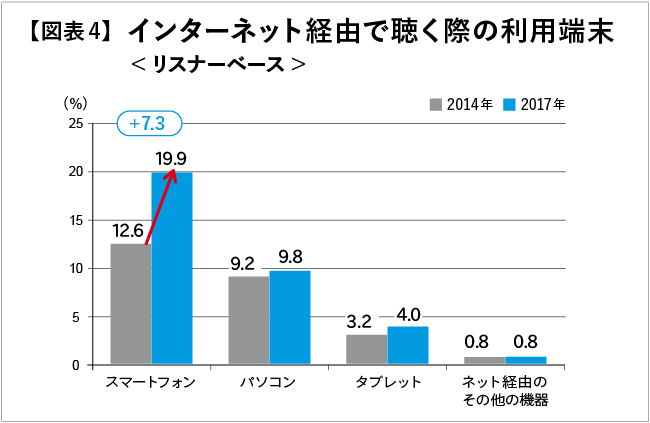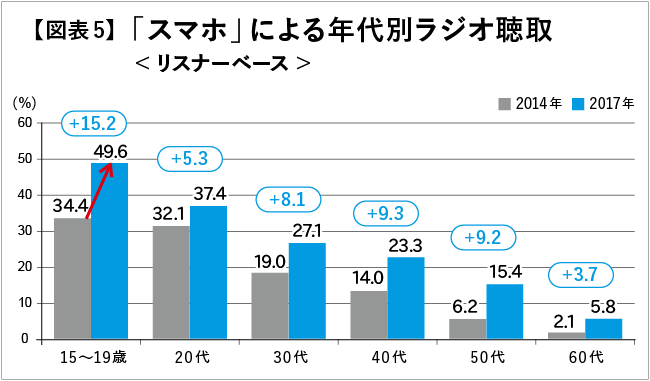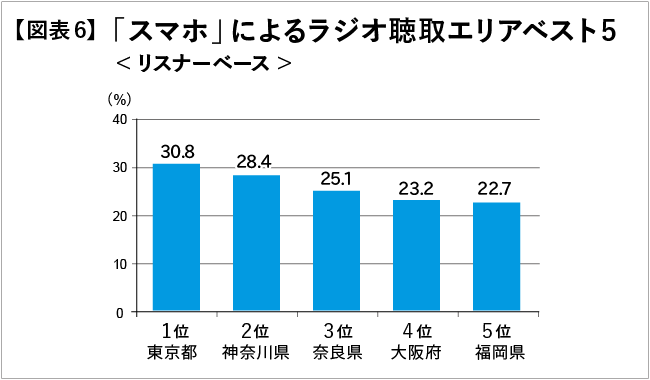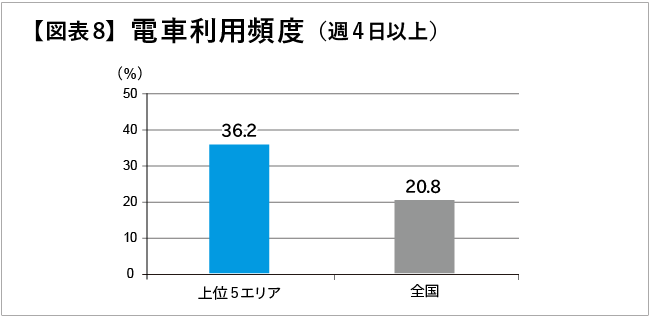Video Research Ltd. regularly conducts "Radio Individual Listening Rate Surveys" in the Tokyo metropolitan area, Kansai region, and Chukyo region to gather data on radio listening habits. The "J-RADIO" survey introduced here allows us to understand daily listening habits by prefecture and the relationship between consumers and radio.
The top area for radio listening is Okinawa Prefecture for the fifth consecutive year!
This issue highlights noteworthy data from the fifth survey.
Once again, "Okinawa Prefecture" ranked highest in radio listening this year. Following in second place were "Iwate Prefecture" (previously 3rd), "Hokkaido" (previously 9th), "Yamanashi Prefecture" (previously 4th), and "Saitama Prefecture" (previously 18th). Excluding Okinawa, the listening rates for these four prefectures were very close, showing nearly identical levels (Figure 1). Okinawa Prefecture has ranked first for five consecutive years since the survey began, while Iwate Prefecture has ranked second for four out of the five years (excluding last year). This clearly shows that these two prefectures have a high number of people who habitually listen to radio.
So why does Okinawa Prefecture have such a high listening habit rate?
Radio is a medium that plays a role not only inside and outside the home but also in automobiles. Therefore, the more frequently people use automobiles, the greater their potential exposure to radio. Examining car usage frequency in Okinawa Prefecture revealed that among those who drive at least occasionally, 69.9% drive daily, compared to 47.7% nationally – a difference of 22.2 percentage points (based on 2017 J-READ results). However, other regions often show higher car usage frequency, suggesting this alone doesn't fully explain the highest listening habit rate.

Shifting perspective slightly to examine "Radio Media Evaluation," we found that Okinawa Prefecture's ratings for radio are exceptionally high. Figure 2 shows the top five items with the largest score differences between "Nationwide" and "Okinawa Prefecture" in "Radio Media Evaluation." In Okinawa Prefecture, ratings were 7 to 15 points higher than nationwide for understanding "local/regional," "world," and "society" movements and events, as well as "latest information," indicating radio is an indispensable medium for daily life.
Furthermore, this evaluation translates into "actions/responses" after listening to radio (Figure 3). The percentage of listeners who took action based on "local information" gained from radio—such as "attending local events" or "visiting a shop featured live on a program"—was 5 to 11 points higher in Okinawa Prefecture compared to the national average.
Furthermore, when ranking these "radio media evaluation" and "actions/responses after listening to radio" scores across all 47 prefectures, Okinawa ranked first in many categories. This suggests that, beyond general societal information, local information is particularly valued, and radio is deeply rooted in daily life. This is likely a key factor in Okinawa's high radio listening habit rate.
Tokyo has the highest number of people listening to radio via smartphone
A recent trend is the growth in radio listening via the internet (Figure 4).
Among these, listening via "smartphones" (hereafter "smartphones") shows a particularly high rate of increase. The 2017 results show a listener base* of 19.9%, a 7.3-point increase compared to 2014, indicating that the habit of listening via smartphones is gradually becoming established.
Therefore, we examined smartphone radio listening in more detail based on the listener base.
* Listener base: People who listened to radio at least once during the week
First, examining the 2017 data by age group reveals that smartphone radio listening is highest among 15-19 year-olds at 49.6%, meaning nearly half of listeners in this group listen via smartphone (Figure 5). Next were those in their 20s at 37.4% and those in their 30s at 27.1%. Currently, smartphone listening appears more prevalent among younger generations. Compared to 2014, the highest increase was among 15-19 year olds, up 15.2 percentage points. Those in their 30s to 50s also saw increases of around 8-9 points.
Looking at regional breakdowns, Tokyo has the highest smartphone listening rate at 30.8%. Following are Kanagawa Prefecture at 28.4%, Nara Prefecture at 25.1%, Osaka Prefecture at 23.2%, and Fukuoka Prefecture at 22.7%, showing urban areas dominate the top rankings (Figure 6).
Looking at the top five areas with the highest smartphone listening rates (Tokyo, Kanagawa, Nara Prefecture, Osaka Prefecture, Fukuoka Prefecture grouped together). Regarding smartphone usage in these top five areas, smartphone ownership stands at 78.1%, slightly higher than the national average of 74.6%. Similarly, internet usage via smartphone in the past year was 74.0% in the top five areas, compared to 69.4% nationally (Figure 7).
Regarding transportation, while cars are the primary mode in regional areas, trains are more commonly used in urban areas. Examining train usage revealed that the proportion of people using trains "four or more days per week" was 20.8% nationwide, compared to 36.2% in the Top 5 Areas, a difference of 15.4 percentage points (Figure 8).
In urban areas, smartphones are a more familiar tool, leading to higher radio listening via smartphones. Furthermore, with more train users, it's likely that more people listen to radio via apps while commuting compared to rural areas.
While the areas with the highest radio listening in Japan were regional areas like Okinawa Prefecture and Iwate Prefecture, in urban areas, many people, especially younger individuals, have the habit of listening to radio via smartphones. Furthermore, smartphone listening is increasing across all age groups, suggesting that this new style of radio listening is becoming widespread.
Survey Content
Survey Item: Time of Day for Regular Radio Listening <Radio Listening Habit Rate>
Stations Surveyed: Commercial AM stations, commercial FM stations, NHK Radio 1, NHK-FM by prefecture
*The survey was conducted as a supplementary survey to J-READ (Japan Newspaper Audit).
J-READ Survey Overview
Survey Area: All 47 prefectures
Survey Participants: Individuals aged 15 to 69 years old at the time of the survey
Valid Sample Size: Total of 28,808 individuals
Sampling Method: RDD (Random Digit Dialing) by survey area
and requested their cooperation
*RDD: A method where telephone numbers are randomly generated and dialed automatically to conduct surveys
Survey Method: Mail survey
Survey Period: October 2017









